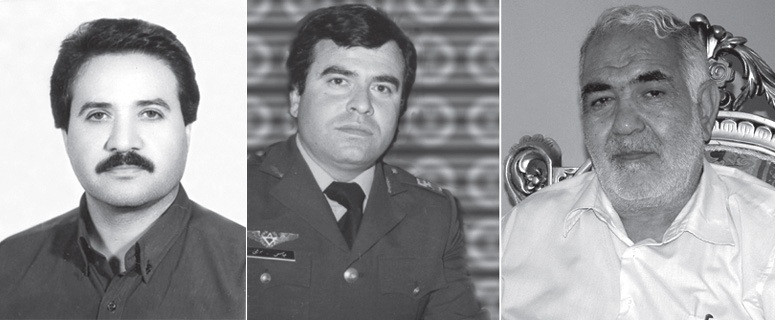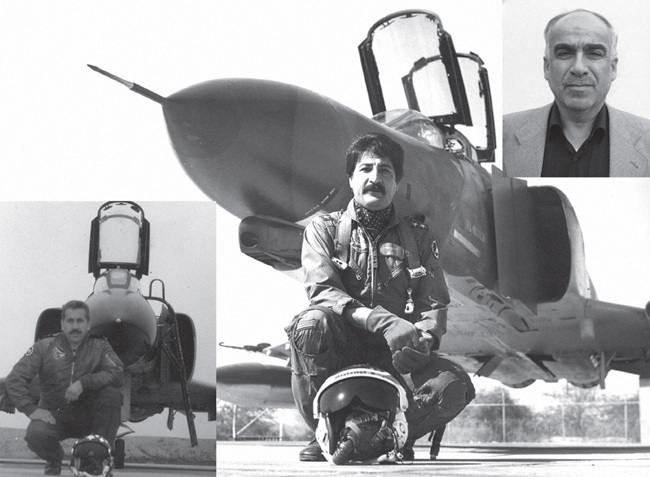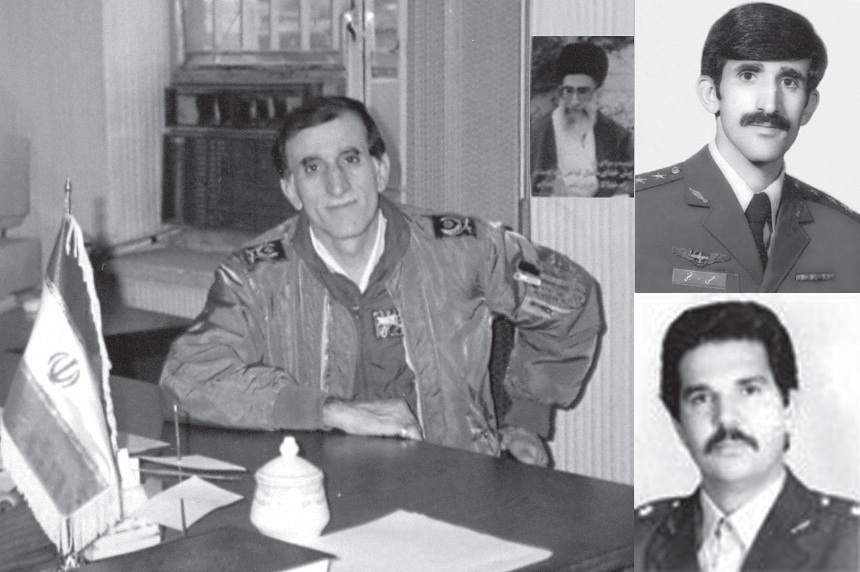Air Raid to Al-Waleed (22)
The Story of Demolishing Fighters and the Equipment in Al-Waleed Triple Military Bases Known as H-3
2016-6-6
Air Raid to Al-Waleed (H-3)
The Story of Demolishing Fighters and the Equipment in Al-Waleed Triple Military Bases Known as H-3
By: Brigadier General Ahmad Mehrnia
Tehran, Sooreh Mehr Publications Company
2010 (Persian Version)
Translated by: Zahra Hosseinian
Another team which plays an essential role in preparing the aircrafts and arming them in three shifts is caring and professional crews of weapons and ammunition battalion. It is worth to study the story from the perspective of mentioned team:
Hearing the sound of the cars’ engines, technicians of flight line and other crews who are present in the hangars notice that the pilots are coming. All run toward them, salute, say good morning, and accompany them to the prepared aircrafts in the hangars. Technical supervisor of maintenance battalion at Hamedan Air Base is chief technician Abbas Moeini who took over the heavy task of preparing phantoms alongside with chief technicians Hamzeh Khodaverdian, supervisor of MC; Hussein Nazaryseir and Ahmad Nikjou, flight line supervisors, Mohammed Aghabeigi, head of aviation electronic; Alireza Abdollahian, maintenance supervisor of base and a few number of other colleagues, and now they were ready to fly them by doing their final duties. Another team led by Second chief technician Ghasemali Hakanlou, the head of ‘armaments and ammunition’, has had well-deserved contribution in preparing of ammunition and installing bombs. Some of these people include: Air force technicians Ghorban Farshidfar, the head of armament branch; Mohammad Mehdi Aslani; Mohammad Aqajani; Mohammad Bagher Bagheri; Heshmatallah sarvari; Hossein Goudarzi, Azim Safarkhanlou; Mahmoud Zainal, Yousefali Mahmoudi, Ahmad Haqsheno Sabet and ...[1].
After much search, I found the position of Abbas Moeini in Hamedan and called him. When I explained to him that what I want to do and I like, if possible, some parts of activities of maintenance battalion are reflected in this book, he accepted happily and asked me to send him my writings to fill him in on more. I immediately posted my writings to his address. A few days later, through a detailed letter with the following introduction, he sent me the names of his colleagues along with memories about the Iraqi attack and also a photo of meeting with the leader of the Revolution; which will be published in another book:

Technical Col. Ghasemali Hakanlou, Abbas Moeini (with First chief air force technician rank, April 1981) and Alireza Abdollahian
"Hello, I hope you are not too tired by working so hard. God willing, you will be successful in your work and leave a valuable relic about facts history and selflessness of honored warriors of Islamic Republic of Iran Air Force during eight years of Sacred Defense.
I carefully read your writings two times, considering the amount of your information, I can say it is excellent.
As I noticed, some of colleagues have written stories in relation to the topic and you have inserted them, I also wrote some of my diaries of command post. You are free to add them wherever you know it is good. I had a photograph from the time I visited Imam Khomeini, and specified the names of my colleagues as much as possible."
He had written the names of his colleagues and continued:
"The command post was then the beating heart of third fighter base and all the areas and operational bases. With a tireless and determined looking, Colonel Golchin was the leader, commander, and director of this beating heart and even had the executive role in operations against enemy. He always wanted to do something memorable for punishing the invader, so that it can be a lesson for all those who dreamed illusion of invasion to Islamic Iran.
In one of winter days, we feel that a peaceful mood has come over Col. Golchin and he sank into thinking hours and tapped on the table, as played piano keys. Shortly after, he suddenly rose up and walked into hallway with quick paces. All these indicated his awareness of compiling the scenario of a great mission and tuning the harmony of an amazing operations and causing a memorable storm: ‘attack to Al-Walee!’"
Retired colonel Hakanlou also says about that time:
"We were busy, 24-hours and all out, preparing all kinds of ammunition for use in war zones from the beginning of the Iraq’s invasion. The colleagues would work hard in the bitter coldness of Hamadan that sometimes reached to 35 degrees below zero, to have a ready aircrafts always. We had also several initiatives to make sure the bombs function accurate, so lest their failure over the targets waste our colleagues’ attempts. Because I do remember that before Revolution, hundreds samples of one type of ordnance didn’t function and made problems for the Iranian Air Force, at the military exercise Midlink[2] in the form of CENTO and the USA presence. Despite military sanctions and various deficiencies, hardworking staff of maintenance battalion in all departments while prepared aircrafts for flight laboriously, as always helped pilots to fasten their seat-belts and other connections such as parachutes and so on, after appearance checking of aircrafts and loaded ammunition.
Again the whispering of The Throne Verse and other prayers can be heard from all. With signaling all things are done. Although the base is far enough from the enemy territory, but according to the brief, no one can use any radio contact at any circumstances. Successful condition is double-checking. With the pilot’s first signal, technicians turn on blower system and high-pressure wind is driven inside engines for starting. One after another aircrafts is switched on.
After no problem is seen with the grace of God and by diligently attempts of crews of maintenance battalion, pilots leave hangars in turn toward the runway. Next to the entrance of runway, a line of ten phantom bombers has been formed. After receiving confirmation from technical crews and assurance of aircrafts’ safety, in this stage ordnance crews remove the safety-catch of bombs and arm machine guns. Now, pilots taxi and enter the runway in turn according to the flight arrangements; and with the green light signal from control tower, while the engine state is one hundred percent, they take their feet from the brake one by one and at a specified interval, and immediately put the gas handle of engines in the afterburner mode. Frightening roar of engines fill the space and heavy irony wing aircrafts leave the base toward a big target. At any moment, the leader look back to see how the state of the rest is and when they join him. Before long, all are in position and fly toward tankers calm and firm on the sky.
Retired technical Colonel Moeini speaks about that event as follow:
"For preparing several aircrafts and loaded them with ammunition without attracting attention, a special program was carried out. The mentioned operation was implemented two more times. Many things had been prepared, including slaughtering a few sheep in front of pilots, but surprisingly, we saw aircrafts returned with their bombs, it means that the operation had not been accomplished. That day, when we heard the pilots headed to the same mission, remembered the story of ‘the boy who cried wolf’ and thought that the aircrafts again will return without following the mission through; but we assured the operation is taking place, when it took a long time. Since we didn’t know the location of target, concern came over all, after passing as expected time as the previous missions. What has happened, have all of them been hit? Have they landed in the base or other runway by reasons? Thoughts like this were bothering all of us when suddenly the deafening sound of Phantoms, which was more pleasant at that moment than the most uplifting music, was heard and the eyes of all colleagues shone joyously."
It should be mentioned that in the Mehrabad Air Base of Tehran and Isfahan Babaei Air Base, as well as Tabriz Air Base, Support Deputy and hardworking staff of maintenance battalion, each one in turn carried out their assigned tasks efficiently and by 24-hours working on three shifts, prepared other participated aircrafts in the operation for flight. We failed to find their names, but congratulate them, since the result of their efforts gave the sweet flavor of a successful operation to Iranian.
Over Lake Uremia, bombers are engaged in refueling and trained F-14 pilots are busy watching in the closest distance to the border and sensitive regions. They have to even penetrate into enemy territory if necessary.
Another part of air cover of West area, continued until after midday, was the responsibility of Hamedan base F-4 pilots, whose names are as follows:
- First Lt. Sadra Aghamiri / First Lt. Koroush Ravandi
(Probably) First Lt. Mohammad Rahim Pourfarzaneh / First Lt. Hossein Mohammadzadeh Cheraghcheeha

In front of Phantom: First Lt. Sadra Aghamiri; Top: Mohammad Rahim Pourfarzaneh; Bottom: Lt. Col. Koroush Ravandi
According to the plan, flying eavesdropping post, C-130 aircraft with the "Khofa’ash" reference and piloting of Capt. Mohsen Najafi and First Lt. Morteza Farokhi[3] entered the operations area a few minutes before taking-off of fighter/bombers; and its hardworking crews sent the latest information for decision makers after eavesdropping and analyzing the Iraqi signal and radio data. It is noteworthy that this important aircraft had no weapon to defend itself and must remain in the closest distance to the enemy border at holding time to collect valuable information. The gathered information by ‘Khofa’ash” in the operation, as well as during the Iran-Iraq war, has had a unique and effective place for involving insider forces. Other crews in ‘Khofa’ash’ aircraft who ran various flight things: Flight Navigators: First Lt. Hooshang Ra’astravan and First Lt. Mirna’aser Sharifvaqeii; Flight Engineer: Senior Master Sgt. Sabzali Maleki (passed away) and first Sgt. katoozi; Load Master (responsible for arranging load): Senior Master Sgt. Hussein Sha'bani and crew chief, First Sgt. Ibrahim Saleh Afzoon.

Second Brigadier General Mohsen Najafi; Top: Najafi with Captain Rank; Bottom: Shahid Morteza Farokhi
It is also appropriate to name effective and hardworking professionals in intelligence command and reconnaissance, who have retired many years. They are as follows: First technician Genghis Khanjani, Mojtaba Maqsoudi, Karim Ramezanpoor, second technician Kazem Lashkari, third technician Barzgaran, first Sgt. Aziz Ja’aberi (from operations), First Lt. Hassan Nazari, and Second technician Fazlullah Naeemian (maintenance battalion).
[1] It should be noted that currently the centralized maintenance battalion has been renamed to "maintenance team". In each air base, this team has two main parts of staff and administrative. According to the type of aircrafts or organizational aircrafts of each base, usually the number of employees who work in six staff branches and executive departments, organizational maintenance, base maintenance, maintenance of aviation electronic, and maintenance of armaments and ammunition, is 750 to 1500. In three shifts and in a coherent and interconnected group, most of crews do the task of repairing, maintenance and preparation of aircrafts; and each has a role in the work.
[2] Midlink was a military exercise that repeatedly was held with the presence of units of US Navy, the UK, Iran Air Force and Navy, Pakistan and some other countries in the region. This exercise was done in order to improve the combat preparedness level and to coordinate combined forces of several countries.
[3] Major pilot Farokhi later was transferred to Falcon jet aircraft and became the pilot of Islamic Republic of Iran hangar. On February 1st 1991, he took a number of authorities to Kermanshah and when returns to Tehran along with copilot Maj. Ali Heydarian, technical First Lt. Iraj Farsi, flight engineer, and Senior Master Sgt. Ibrahim Islami, from protection staff, had an accident near Harsin and all martyred. Soul be rest in peace.
Number of Visits: 4797








The latest
Most visited
A section of the memories of a freed Iranian prisoner; Mohsen Bakhshi
Programs of New Year HolidaysWithout blooming, without flowers, without greenery and without a table for Haft-sin , another spring has been arrived. Spring came to the camp without bringing freshness and the first days of New Year began in this camp. We were unaware of the plans that old friends had in this camp when Eid (New Year) came.
Attack on Halabcheh narrated
With wet saliva, we are having the lunch which that loving Isfahani man gave us from the back of his van when he said goodbye in the city entrance. Adaspolo [lentils with rice] with yoghurt! We were just started having it when the plane dives, we go down and shelter behind the runnel, and a few moments later, when the plane raises up, we also raise our heads, and while eating, we see the high sides ...The Arab People Committee
Another event that happened in Khuzestan Province and I followed up was the Arab People Committee. One day, we were informed that the Arabs had set up a committee special for themselves. At that time, I had less information about the Arab People , but knew well that dividing the people into Arab and non-Arab was a harmful measure.Kak-e Khak
The book “Kak-e Khak” is the narration of Mohammad Reza Ahmadi (Haj Habib), a commander in Kurdistan fronts. It has been published by Sarv-e Sorkh Publications in 500 copies in spring of 1400 (2022) and in 574 pages. Fatemeh Ghanbari has edited the book and the interview was conducted with the cooperation of Hossein Zahmatkesh.

